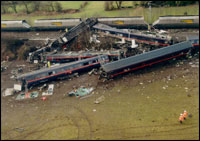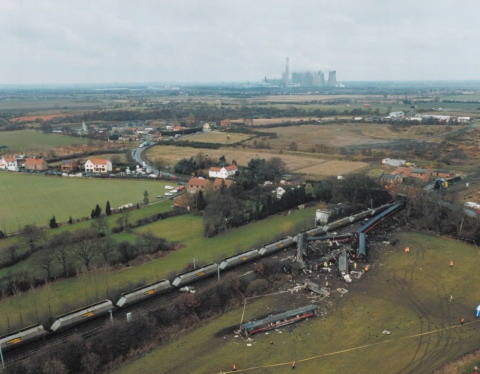Greta Heck, Selby 28. januar 2001
En landrover kørte af vejen ved en bro og ind på sporet. Efterfølgende ramtes den af et hurtigtkørende persontog på vej mod syd. Dette afsporedes og ramtes da af et nordgående godstog. 10 mennesker omkom og 82 blev kvæstet.
Railways Archive summary
On Wednesday 28 February 2001, the 04h45 Great North Eastern Railway (GNER) passenger train left Newcastle on route to London Kings Cross. At approximately 06h12, while it was still dark, a Land Rover pulling a trailer loaded with a Renault car left the west bound carriageway of the M62 motorway at Great Heck, between junctions 34 and 35. The Land Rover and trailer continued along the steep road embankment and subsequently down a railway embankment and came to rest, fouling the Up mainline, on the south side of the M62 over-rail bridge at a point located at about 170 miles from London up the East Coast Main line (ECML).
The road vehicle driver survived the incident and made a telephone call to the emergency services. As he was talking to the emergency services (at about 06h14), the south bound GNER express passenger train struck the Land Rover. The train, which was travelling at around the line speed of 125mph, was an Intercity 225 propelled by a Class 91 locomotive and consisted of a leading Driving Van Trailer (DVT), eight Mark IV passenger carriages, and a buffet car. The DVT became derailed at a point approximately 15 metres to the south of the impact and then travelled in a derailed condition, staying substantially in line and upright, for approximately 700 metres until it reached a set of points associated with sidings.
Evidence suggests that these points further deflected the DVT towards the opposite track. At this point, in the vicinity of road bridge ECM 2/7, it was hit by a northbound freight train. The freight train, operated by Freightliner, carrying over 1000 tonnes of coal and hauled by a Class 66 locomotive, was the 05h00 from Immingham to Ferrybridge which had departed early at approximately 04h17 and was around 20 minutes early at the point of collision. It was travelling close to the maximum permitted line speed for freight of 60 mph. As a result of the second impact, the GNER train became virtually completely derailed and descended the embankment into an adjacent field to the south side of overbridge ECM 2/7. The Class 66 locomotive of the Freightliner train also became derailed into the garden of a railside property north of that overbridge on the down side.
Executive summary af preliminær rapport
- 2.1 The initial derailment of 1F23 was as a result of a collision with a Land Rover obstructing the Up line at a location near to where the M62 motorway crosses the East Coast Main Line. The speed of the train at the time of the collision was thought to be at or near the line speed of 125 mph.
- 2.2 The subsequent collision between the passenger and freight trains arose through a combination of factors including the location of the turnout to Plasmor sidings, deflection of the derailed leading vehicle of the passenger train and the approaching freight train heading north on the Down Line.
- 2.3 Early in the investigation it became apparent that the incident was related to the initial impact with the road vehicle and unlikely to be associated with any failing in respect of Health and Safety legislation by the railway infrastructure controller (Railtrack) or the train operators (GNER and Freightliner).
- 2.4 All the railway companies who commissioned technical investigations by consultants agreed to the findings being shared. All the investigative work was subjected to critical review by HSE.
- 2.5 A significant role of HSE became the provision of technical advice and guidance on incident related railway issues to British Transport and North Yorkshire Police.
- 2.6 The driver of the Land Rover was subsequently convicted of ten charges of causing death by dangerous driving at Leeds Crown court on 13 December 2001 and sentenced to five years imprisonment.
- 2.7 The railway industry, under the direction of Railway Safety, carried out a formal inquiry into the circumstances of the incident that resulted in a number of recommendations. A summary of the main recommendations is included in an appendix to this report.
- 2.8 At the request of the Deputy Prime Minister the Health and Safety Commission set up a working group to examine the obstruction of railway lines by road vehicles. The HSC findings have been set out in a report titled Obstruction of the railway by road vehicles.
- 2.9 During the subsequent investigation by HSE and the railway industry no defects were found with the infrastructure, rolling stock or personnel competencies that could have contributed to the outcome of the incident.
- 2.10 Condition of the road infrastructure complied with standards applicable at the time of the collision. Recommendations within the Railway Safety and HSC reports have initiated actions to review the adequacy of these standards.
- 2.11 During the course of the incident six passengers and four train crew were fatally injured and a significant number of passenger and train crew received varying degrees of injury.
- 2.12 The closing speed of the trains involved in this collision was estimated to be in the region of 142 mph. The severity of the collision was outside the parameters of all recognised crashworthiness standards. However, bearing in mind the high closing speed, it is the opinion of the investigators that the rolling stock performed adequately in terms of crashworthiness in that survival space was to a large extent maintained.
- 2.13 HSE has initiated further research into the effects of collisions with obstructions in relation to different passenger train formations, and the containment of fuel in diesel tanks.

